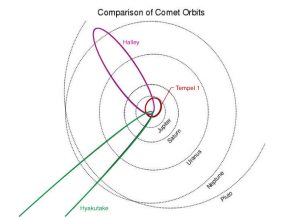
Planet X (Nibiru) is supposed to whip around from behind the sun and near-smack us every 3600 years. Almost all of the scenarios I’ve seen on YouTube require a complete suspension of orbital mechanics as currently understood.
What sort of bizarre cometary orbit would be required to keep a planetary body close enough to the sun’s visible position from Earth so as to make such a scenario even remotely possible? I personally cannot fathom how the conspiracy theorists imagine that a planet could escape notice until it was very nearly upon us.
The short answer is that it simply isn’t possible to have an orbit that would keep a Planet X behind the Sun as seen from Earth, and also allow it to encounter the Earth every 3600 years (or ever).
Because the Earth moves around the Sun on its orbit, the only way to keep another planet permanently behind the Sun as seen from Earth is for it to orbit the Sun in the same amount of time as the Earth, that is, one year. If it had any other orbital period, it would be visible away from the Sun for long periods of time, like the other planets in our solar system. If Planet X had a circular orbit with a period of one year, it could always be exactly behind the Sun as viewed from the Earth–but this would mean that it could never come close enough to the Earth for a close encounter!
What if, instead, we give Planet X a very elongated, comet-like orbit like you proposed, while keeping the orbital period at one year? For this, we need one key point from Kepler’s Laws: planets and other orbiting objects move faster when they are closer to the Sun, and slower when they are farther away. A consequence of this is that Planet X will spend more time moving slowly far from the sun than moving fast close to the Sun. Because of this, as we make the orbit more and more elongated, it becomes harder and harder to hide Planet X behind the Sun. The farther it can go from the Sun, the more the Earth can catch up to it when it is moving slowly far from the Sun, and the farther from the Sun it will appear to be when viewed from Earth. But, again, since the orbital period of Planet X is still one year, and it is always nearly on the opposite side of the Sun from the Earth, it can never actually have a close encounter with the Earth.
I hope that this adequately answers your question.
Marshall Johnson